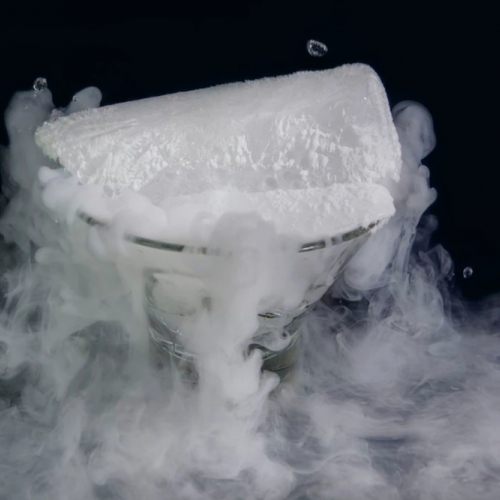Everything you need to know about Dry Ice
CAUTION: Reliance on any information provided by Reddy Ice on the website / blog is solely at your own risk.

Dry ice – you probably know it best from the dramatic fog it creates or for keeping your weekly meal kits cool until they reach your front door. But what exactly is dry ice?
Dry ice is carbon dioxide that has been liquefied and then frozen to a temperature of -109 degrees Fahrenheit. It is dry ice’s incredibly low temperature (typical ice has a temperature of 32 degrees Fahrenheit) and sublimation that makes it unique and useful.
“Sublimation” is the term for the process where solid dry ice turns directly into carbon dioxide, rather than melting into a liquid. It’s the sublimation process that results in the “smoke” that dry ice creates.
What is Dry Ice Used For?
Dry ice has several uses, but the most common is for transportation.
The medical field uses dry ice to transport items that need to maintain a specific temperature, such as organs for transplant or COVID vaccines. Since dry ice evaporates rather than melts, there is less risk of bacteria or other contamination that can occur with water residue.
The food and agricultural industries also use dry ice. Not only does the low temperature keep items cool and from spoiling, but it kills bacteria on contact.
Dry ice cleans up in another form: blasting. Compressed air turns dry ice into pellets which are then sprayed onto the surface that needs to be cleaned. The dirt actually shrinks when the cold air hits in, making clean up much easier. Thanks to the fact that no secondary waste is created when cleaning with dry ice, it is considered environmentally friendly.
While you may not be blasting your kitchen floor clean with dry ice anytime soon, there are several at home uses for the product.
Dry ice is often used in beverages such as cocktails or punch to create a smoking effect. It is safe to drink a beverage after dry ice has been used in it, but you must wait until the “smoking” has completely stopped and the ice has melted before ingesting the drink.
Here’s a unique way to keep the mosquitoes away—dry ice! Mosquitoes use the carbon dioxide that humans exhale to locate them. Confuse the pesky insects by setting out bowls of dry ice when you’re outside so that they are attracted to the dry ice rather than you (before handling or using dry ice – see “How to Handle Dry Ice” below).
Skip taking your car to the mechanic to remove that dent from your bumper and use dry ice instead. Wrap the dry ice in a soft, thick towel before rubbing it around and over the dent in circles. The dry ice makes the metal so cold that it retracts and the dent naturally releases (before handling or using dry ice – see “How to Handle Dry Ice” below).
How to Handle Dry Ice
Before you utilize dry ice for one of its many purposes, it’s important to know how to handle the substance.
ALWAYS ventilate the area where the dry ice is sublimating. Ventilation is important factor when using dry ice. The side effects of carbon dioxide overexposure are headaches, nausea, and vomiting.
NEVER touch dry ice without wearing thick gloves as the extreme temperature can burn unprotected skin.
NEVER taste or swallow dry ice. Carbon dioxide is heavier than air and will concentrate when used within an enclosed space. It’s important to ensure that you use dry ice in a well-ventilated area because as it sublimates and carbon dioxide is released, you run the risk of breathing in toxicity.
NEVER transport dry ice in an enclosed vehicle. Carbon dioxide can become toxic if it begins to concentrate in an enclosed space.
NEVER store dry ice in a sealed container or it could explode. As dry ice sublimates, it releases pressure. The best storage container is styrofoam.
NEVER dump dry ice down a sink or toilet because the extreme cold could harm the plumbing parts. If you do accidentally put dry ice down a sink drain, then run hot water to increase the sublimation process and avoid freezing the pipes. Sublimation in a well-ventilated area is the safest way to dispose of dry ice.
The Demand for Dry Ice
There is a higher demand for dry ice than in previous years due to the medical field’s need to use it for vaccine transportation. The Pfizer and Moderna coronavirus vaccines must be stored and transported at a specific temperature to remain effective. But vaccines are not the only reason why dry ice is in such high demand. With so many people staying at home over the past year, food deliveries and shipments have skyrocketed, and the need for dry ice along with it.
There is also an essential ingredient facing a supply shortage: carbon dioxide. Carbon dioxide is captured when ethanol is produced. With fewer Americans driving, there was less demand for the ethanol that makes up 10 percent of the fuel supply. This means less ethanol was produced and therefore less carbon dioxide.
Where to Buy Dry Ice
However you decide to use dry ice, Reddy Ice is here to help!
Check out our dry ice page for the Reddy Ice locations that offer this product.
